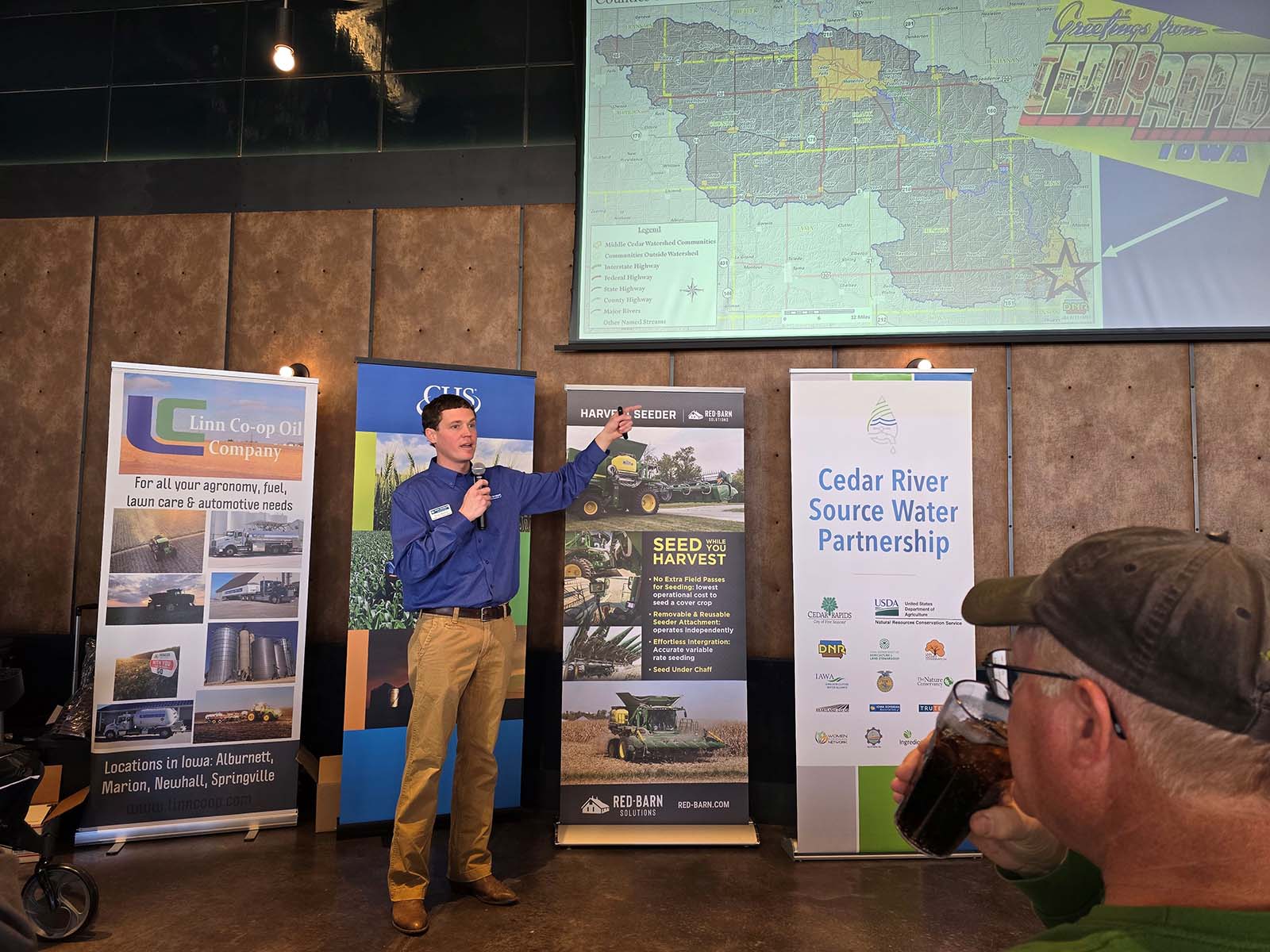
(Photo credit: Jeff Hutton/Iowa Soybean Association)
Brewing Conservation on the Cedar
March 13, 2025
By Jeff Hutton
How is enjoying a beer connected to what happens upstream on the farm?
As part of the “Brewing Conservation on the Cedar” event at Big Grove Brewery in Cedar Rapids on Wednesday, participants learned about the impact conservation practices has on water quality, whether it’s at the brewery or with the water coming out of residential tap.
“Understanding the importance of water really serves all of us,” says Iowa Soybean Association (ISA) Conservation Agronomist Evan Brehm.
He highlighted the Middle Cedar River Watershed, an area that spans 10 counties in eastern and east-central Iowa – that’s 1.5 million acres of farmland, 75% of which is row crops.
Brehm says understanding that practices in the 10 counties affect the watershed which in turn affects water quality downstream to the city of Cedar Rapids and other communities.
Conservation on the farm
Brehm says the Cedar River Source Water Partnership (CRSWP) has been instrumental in pulling together farmers, ag retailers, municipalities like Cedar Rapids and others in making a difference.
“This really about rural and urban coming together, focusing on agricultural practices and how they have an effect downstream,” he says.
Brehm pointed to Linn County farmer Jim O’Connell, who has been engaged in numerous conservation practices on his farm for several years.
Brehm says O’Connell may just be the model for conservation-minded producers who are trying to be effective both on the farm and beyond.
O’Connell, who was recently awarded the American Soybean Association Midwest Region Conservation Legacy Award during this year’s Commodity Classic in Denver, Colo., has been engaged in numerous conservation practices for more than 10 years.
No-till, strip-till, cover crops, planting green, edge-of-field implementation, the establishment of a wetland, saturated buffers and bioreactors – all part of O’Connell’s operation.
“I believe these practices are making a difference,” says O’Connell.
“When we put in the wetland a few years, we saw that the nitrate levels were much lower. I think I’m doing my part in cleaning the water, because these edge-of-field practices, batch and build, saturated buffers and bioreactors are working.”
O’Connell has been facilitating the use of cover crops for roughly 15 years.
Starting slow by initially committing cover crops to about 20 acres of soybeans and 20 acres of corn, the results were evident soon after for O’Connell.
“Twelve days after planted (the cover crops), we received about 5.5” of rain and I noticed the water was running clear,” he says.
“I think cover crops are a valuable tool, because our nitrates and chemicals are staying where they need to stay in the field and not going into the streams and river.”
And those efforts have also saved O’Connell money with less reliance on herbicides and chemicals. It’s also improved soil quality and clearly helps with moisture retention.
O’Connell says while he doesn’t want to dictate to other farmers about cover crops and other environmentally friendly practices, he believes the efforts are worth looking at.
“Don’t be afraid to try something new,” he says, adding that with water quality, “it takes all of use to work together.”
Partnership is working
Chris Flenker, head brewer for Big Grove Brewery, says he was pleased to host this event because he knows the efforts being made by O’Connell and other farmers, as well the partnership with the city of Cedar Rapids, is good for his operation.
“Water is the most important ingredient in beer,” he says. “In terms of the environmental aspects, it’s great to be part of this. Cedar Rapids has the best water in the state and we’re very passionate about that.
Mary Beth Stevenson, watershed and source water program manager for City of Cedar Rapids, agreed with Flenker, and says recognizing water quality and its value to the community is critical.
“Thank you for caring about water quality,” she says as she addressed audience members. “Everything that you do matters to us downstream in Cedar Rapids.
Stevenson says Cedar Rapids’ quality drinking water should not be taken for granted.
Whether it’s the water necessary for Flenker’s beer, the water that flows through residential taps or the water that is necessary for all the agricultural industries located in Cedar Rapids. In fact, 70% of Cedar Rapids’ water go to processing facilities in the community like ADM, Quaker Oats and many more.
“It’s all very connected and influenced by what happens upstream,” she says.
“It’s clear that agriculture is a big part of our economy in Cedar Rapids and that’s why the CRSWP is so important.”
Stevenson says the city recognizes the value in cover crops, bioreactors, saturated buffers and edge-of-field practices on farms upstream from Cedar Rapids
“When you’re implementing practices on your homes farms, you’re not only helping Cedar Rapids, but your friends and families and anyone with concerns about nitrate loss,” she says.
“We are deeply appreciative for all our partners because we can’t do it alone. We need everyone to do their part because our goal is clean, delicious drinking water that supports industries and taps at home.”
Working together
Brehm says conservation practices are growing in eastern Iowa and across the state.
“In 2009, we had less than 10,000 acres with cover crops in the state,” he says. “Last fall, we were just shy of 3.8 million acres. Farmers are doing the work and it’s making a difference.
And in the Middle Cedar River Watershed, Brehm says other practices have proven successful.
In 2024 within the watershed, there were 40 saturated buffers and 33 bioreactors that had been established.
“The genius idea of batch and build, buffers, bioreactors, wetlands, cover crops – these are really working,” Brehm says. “Long-term conservation practices are making a difference. And it’s about being collaborative because we’re all in this together.”
Back